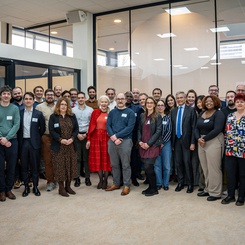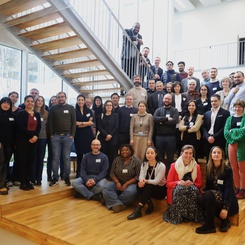Everyone is talking about artificial intelligence large language models (LLMs) like ChatGPT - with excitement and with a bit of trepidation, too. How will it change how we work and learn? How can we harness its power? And of course, the ever-present: and will it replace us?
Maciej Workiewicz, Associate Professor of Management at ESSEC, researches how organizations adapt to change, like the kind of technological change artificial intelligence engenders. He shares his thoughts on how business and higher education can use these tools to their advantage.
He notes that mastering these tools requires practice: learning by doing. Users need to get a feel for the model, to see what prompts work and what doesn't: they can ask the same question in different ways, and observe and reflect on changes as the model evolves. Furthermore, as the technology rapidly evolves, some approaches that didn’t work well in the past may now become usable and one needs to keep using the technology in order to keep up. Sam Altman, the CEO of OpenAI, made this point quite effectively during arecent interview with Lex Fridman. Supporting this is the number of job postings for “prompt engineers” popping up on LinkedIn and Indeed: this new and lucrative position involves inputting the most optimal queries into your LLM of choice, to get the best possible replies. But what if you aren’t a prompt engineer?
As Dr. Workiewicz notes: “As a tenured academic, I'm privileged because learning, trying, failing, and testing are part of my job description. But what about other knowledge workers who must meet deadlines or have teammates who depend on them? It's unrealistic and perhaps unfair to expect them to explore AI during their personal time.”
How can companies optimize their use of this technology?
While these tools are user-friendly, it takes more than creating your account and asking a few questions to make the most of it. Dr. Workiewicz outlines some suggestions for companies and individuals looking to take full advantage from LLMs and AI:
- Allocate designated exploration time: Allow employees to explore AI tools, like GPT, during work hours. This will help them build confidence and expertise without sacrificing personal time.
- Provide training and resources: Offer structured training sessions and materials to help employees understand the tool’s capabilities, limitations, and best practices.
- Foster a culture of sharing: Encourage employees to share their experiences, insights, and tips with colleagues.
- Balance exploration and exploitation: The late James March, Professor at Stanford GSB, who spent his career studying organizations and learning, used to say that exploiting current capabilities is seductive for organizations. It is less risky, the effects are immediate, and people know what to do. In an era of rapid transformation, organizations often find it easier to maintain the status quo. Hindered by organizational inertia, which stems from rigid hierarchies and complex processes, or by simple complacency brought on by years of strong performance, many organizations grapple with recognizing the need for change. By concentrating on the practices that contributed to past successes, these organizations may experience short-term efficiency, but at the expense of long-term preparation and adaptability. This strategy may be problematic even in times of relative stability and technological continuity; however, it can prove to be disastrous when the landscape experiences a sudden shift. It is arguably certain that we currently find ourselves in such a period of change.
- Thus, last but not least, one should keep evaluating the impact of GPT (or similar technology) on productivity and make necessary adjustments to ensure a balance between exploration and exploitation.
GPT forces changes to education as well
Artificial intelligence is sure to have an impact on higher education institutions too - indeed, organizations like UNESCO and the European University Associationare starting to analyze its potential impact and provide guidelines for its implementation.
Dr. Workiewicz notes: “Disruption is a familiar topic in business schools, where we teach future leaders the importance of adapting to changes in technology, society, and regulations. Now, disruption has arrived in our classrooms, forcing us to reevaluate our teaching methods and adapt to new AI technologies. GPT is a powerful AI language model capable of generating high-quality text in response to complex questions.”
The impact of GPT is already apparent. Students can easily access tools online that provide well-articulated answers to nuanced problems. The line between AI-generated text and human-written content is blurring, making it difficult, if not impossible, to detect plagiarism. This development challenges the status quo in business education and demands that we rethink our teaching methods as well as what we teach.
As we venture into the era of GPT and other advanced AI technologies, it is essential for educators to understand and integrate these tools into their curriculums. GPT can be used to prepare teaching plans, create personalized exercises, help students brainstorm ideas, and act as a simulated exercise partner in negotiations or case analysis. The applications are numerous, and every day an application update brings new possibilities. These creative applications of AI will not only enable productive classroom discussions: it will also ensure that our students are prepared for the changing labor market and economy. The need for continuous education is more pressing than ever, as our alumni will also benefit from learning new skills to thrive in this rapidly evolving landscape.
The potential of GPT extends beyond academics, with significant gains in productivity observed in fields such as computer coding, journalism, and text editing. It is clear that we cannot ignore the transformative power of this technology, which is poised to reshape our lives and work. By embracing AI tools like GPT and learning how to cooperate with them, students and managers alike can amplify their impact in the business world. We have the tools. Now we need to make time to use them.
A final thought
One of the key principles behind OpenAI is that if we introduce AI early and develop it slowly, we will give society and our institutions time to adjust to them, find productive uses and approaches and guard against malevolent applications. But we need to start early and invest sufficient time to allow organizations and institutions to integrate this tool into their workflows. Similarly, business schools, and the educational sector in general, should embrace this new technology as soon as possible so that fresh graduates and experienced managers are kept up to date in terms of knowledge and skills. Otherwise, all this extra headstart will be for nothing.
For more insights from Maciej Workiewicz, check out his blog.









